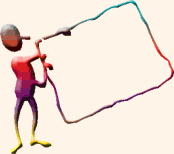 Sockets Sockets
For basic communication, Java supports sockets. Sockets are used to
establish communication between machines, sometimes used to establish
communication between two processes on the same machine. Socket is just
a channel through which applications can connect and communicate with
each other. Sockets are generally of two types:
 Connection-oriented Connection-oriented
 Connectionless. Connectionless.
A connection-oriented service is modeled after the telephone system,
whereas a connection-less service is modeled after the postal system.
Sockets are flexible and sufficient for general communication but they
are not well suited to handle complex data types. Moreover, sockets
are unsuitable for developing complex applications.
 Remote Procedure Call (RPC) Remote Procedure Call (RPC)
An alternative to sockets is RPC. RPC enables an application to call
procedures that exist on another machine. RPC makes a network connection
to a remote machine using sockets. After the connection is made with
the server, one can invoke a function on the remote machine. The programmer
has the illusion of calling a local procedure, but actually the arguments
are packaged and passed to the remote machine. RPC is easier to use
than sockets. There are some drawbacks of using RPC, such as:
- You can only pass simple data types & not objects as arguments.
- The programmer must learn a special Interface Definition Language
(IDL).
 Common Object Request Broker Architecture(CORBA) Common Object Request Broker Architecture(CORBA)
CORBA is a middleware technology developed by a consortium called OMG
(Object Management Group). It is used mainly for applications in distributed
architecture. Fundamental to the Common Object Request Broker Architecture
is the Object Request Broker (ORB). An ORB is a software component used
to establish communication between objects. The advantages of CORBA
are:
- It enables access to software running on different platforms.
- It is language neutral.
 Distributed Component Object Model (DCOM) Distributed Component Object Model (DCOM)
Microsoft(s) DCOM is an extension of the COM. COM is used to develop
distributed applications on the same machine. DCOM places COM applications
on the network. One of the limitations of using DCOM is that it can
communicate only between applications developed in windows environment.
 Remote method Invocation (RMI) Remote method Invocation (RMI)
RMI is used to develop distributed applications. RMI has been specifically
designed to operate in Java environment. Calling a remote method is
almost the same as calling a local method. RMI uses a registry service
for registering and locating objects. All marshaling of parameters and
return values is taken care of by the system. An advantage of using
RMI is that there is no need to learn another IDL language.

A lot of people get confused between a computer network and a distributed system. Actually, the main
difference between a distributed system and a network is: The user of
a distributed system is not aware that there are multiple processors
but with a network, users must explicitly log on to other machine, submit
jobs, transfer files, etc.
between a computer network and a distributed system. Actually, the main
difference between a distributed system and a network is: The user of
a distributed system is not aware that there are multiple processors
but with a network, users must explicitly log on to other machine, submit
jobs, transfer files, etc.
A number of methods exist for developing network applications (e.g.,
sockets, RPC, RMI, CORBA, DCOM). All these methods have some advantages
and disadvantages.
|